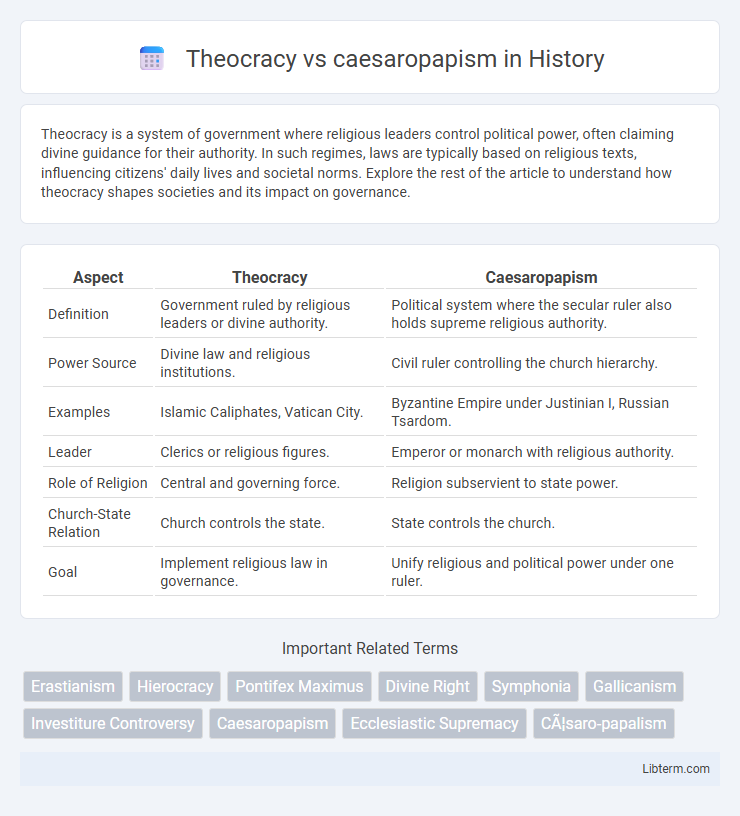Theocracy is a system of government where religious leaders control political power, often claiming divine guidance for their authority. In such regimes, laws are typically based on religious texts, influencing citizens' daily lives and societal norms. Explore the rest of the article to understand how theocracy shapes societies and its impact on governance.
Table of Comparison
| Aspect | Theocracy | Caesaropapism |
|---|---|---|
| Definition | Government ruled by religious leaders or divine authority. | Political system where the secular ruler also holds supreme religious authority. |
| Power Source | Divine law and religious institutions. | Civil ruler controlling the church hierarchy. |
| Examples | Islamic Caliphates, Vatican City. | Byzantine Empire under Justinian I, Russian Tsardom. |
| Leader | Clerics or religious figures. | Emperor or monarch with religious authority. |
| Role of Religion | Central and governing force. | Religion subservient to state power. |
| Church-State Relation | Church controls the state. | State controls the church. |
| Goal | Implement religious law in governance. | Unify religious and political power under one ruler. |
Understanding Theocracy: Definition and Core Principles
Theocracy is a system of government where religious leaders hold political power, integrating divine authority with state governance to enforce laws based on religious doctrine. Core principles include the supremacy of religious law over secular laws, the belief that political authority is derived from divine will, and the fusion of religious and political institutions. Unlike caesaropapism, where a secular ruler controls religious institutions, theocracy centralizes both spiritual and temporal power within clerical authorities.
What is Caesaropapism? Origins and Key Features
Caesaropapism is a political-religious system where the secular ruler also holds supreme authority over the church, merging political and religious power. Originating in the Byzantine Empire, this concept demonstrated the emperor's ultimate control over ecclesiastical matters, combining imperial and spiritual leadership. Key features include centralized governance, state dominance over religious institutions, and the ruler's role as both political leader and religious head, distinguishing it from theocratic systems where clergy wield ultimate authority.
Historical Roots: The Evolution of Theocracy and Caesaropapism
Theocracy's historical roots trace back to ancient Mesopotamia and Egypt, where rulers were often seen as divine or directly chosen by gods, establishing governance intertwined with religious authority. Caesaropapism emerged prominently during the Byzantine Empire, characterized by the emperor's dual role as both political leader and supreme head of the church, blending secular and ecclesiastical power. These evolutions reflect distinct models of governance where religion and state authority converge, influencing the political-religious dynamics throughout history.
Political Authority in Theocracy vs Caesaropapism
Political authority in theocracy is derived from divine guidance, where religious leaders rule based on perceived God's will, merging spiritual and administrative power. In caesaropapism, the political ruler holds supreme power over both state and church, subordinating religious authority to imperial governance. This distinct division highlights theocracy's emphasis on religious legitimacy, contrasting with caesaropapism's prioritization of centralized secular control over religious institutions.
Religious Leadership: Clergy versus Monarchs
Theocracy centers on religious leadership dominated by clergy, where spiritual authorities hold ultimate governance based on divine law and religious doctrine. Caesaropapism combines religious and political authority under a monarch, where the ruler exercises supreme control over both church and state institutions. This fusion prioritizes monarchical power over clerical autonomy, blending secular and sacred leadership roles.
Major Examples of Theocracies in World History
Major examples of theocracies in world history include the Papal States, where the Pope held both religious and political authority, and ancient Egypt, governed by Pharaohs considered divine rulers. The Islamic Caliphates, particularly the early Rashidun and Umayyad dynasties, combined religious leadership with state power, exemplifying theocratic governance. Unlike theocracy, caesaropapism merges ecclesiastical and imperial authority in one figure, as seen in the Byzantine Empire where the emperor exercised supreme control over the church.
Notable Caesaropapist Regimes and Their Impact
Notable caesaropapist regimes, such as the Byzantine Empire and Tsarist Russia, centralized both political authority and religious leadership under the ruler, blending state and church powers to enforce uniformity and bolster imperial control. This fusion often led to the suppression of dissenting religious views while strengthening national identity through state-sponsored Orthodoxy. The impact included the consolidation of autocratic rule and lasting influence on governance models that conflated religious legitimacy with sovereign authority.
Theocracy vs Caesaropapism: Similarities and Differences
Theocracy and caesaropapism both involve the intersection of religious authority and political power, where governance is influenced by religious principles, but they differ fundamentally in leadership structure. Theocracy vests supreme authority in a religious leader or clergy who governs in accordance with divine law, while caesaropapism merges ecclesiastical authority with the sovereignty of a secular ruler, often an emperor who controls the church. Both systems blur the lines between church and state, yet theocracy prioritizes theocracy's clerical dominance, whereas caesaropapism emphasizes political supremacy over religious institutions.
Socio-Political Implications of Each Governance Model
Theocracy centralizes political power in religious authorities, directly intertwining spiritual doctrine with legislative processes, often leading to laws heavily influenced by religious morals and limited pluralism. Caesaropapism merges secular and religious leadership under a single ruler, which can streamline decision-making but risks consolidating excessive power and suppressing religious independence. Both governance models impact societal control, individual rights, and the balance between religious influence and state authority, shaping cultural cohesion and political stability differently.
Modern Perspectives: Relevance of Theocracy and Caesaropapism Today
Modern perspectives on theocracy emphasize its influence in countries like Iran, where religious authority directly governs political power, highlighting challenges to secular governance and human rights. Caesaropapism remains relevant in constitutional monarchies such as the United Kingdom, where the monarch holds a formal religious role while political authority is exercised democratically. Contemporary debates focus on the balance between spiritual legitimacy and political authority, assessing how these governance models impact modern state sovereignty and pluralism.
Theocracy Infographic

 libterm.com
libterm.com